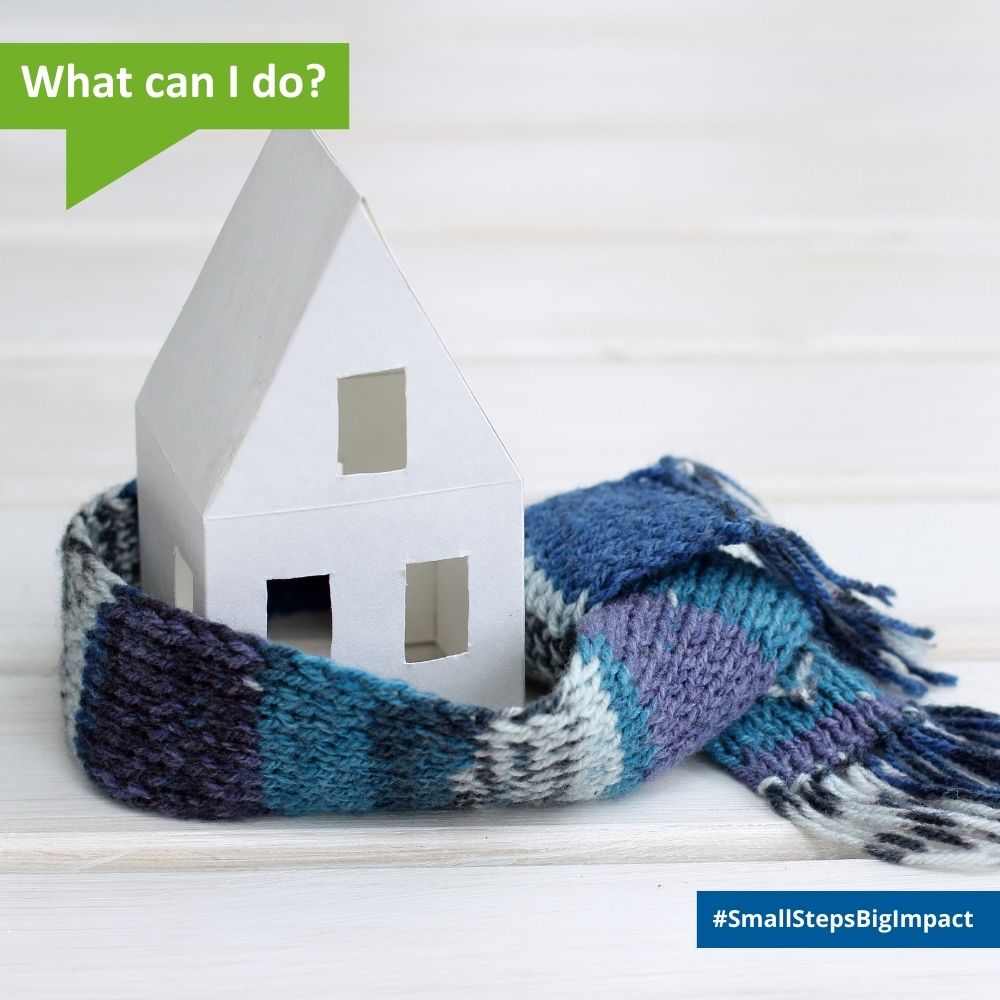The Circular Dorking Blog
Retrofit of Housing for More Sustainable Energy
10th February 2025

Part of our ‘What can I do?’ guides
Some thoughts and ideas from Paul Street our Circular Dorking expert on all things heating and energy
Consider these quick fixes:
Insulation
Step 1 – Maximise the insulation (loft, wall, floor, draft exclusion). Especially seal places like where pipes enter the kitchen or cables enter under the stairs, etc. Often kitchens (behind cabinets) are a source of drafts. Go beyond the minimum level (thickness) of insulation required in the UK building regulations.
Step 1a – Consider flooring. How well is this fitted, sealed? Carpets with underlay add to floor insulation. Consider thicker underlay or insulation sheets.
Laminate flooring does not touch the walls (due to expansion) so ensure that the underlay does and is sealed well.
Step 1b – Ventilation. Consider kitchen, bathroom, shower room and toilet ventilation fans, ensure they have self-closing louvres.
Windows and doors
Step 2 – Get double glazing.
For old double glazing (>10yr old) the seals will probably have failed and their performance will be low. Modern double glazing is much better thermal performance than 15 years ago. Triple glazing has marginal additional benefit but is better if you can afford it.
If you can’t fit double glazing, the next best thing is secondary glazing (a window inside the existing window; this can often be done as a DIY project).
- Slatted blinds or thick curtains can make a big difference in heat loss or gain (in the summer)
- Entrance porch (ie. two levels of doors to access the property) can make a thermal difference.
- Letter boxes – consider the letter box that doesn’t ingress through the door. ie. an external box. Or get a letterbox draught excluder.
- Cat flaps – often let a gail blow into your house. A huge amount of heat can be lost. Get a good quality cat flap that seals well.
Energy Efficiency
Step 3 – Get A+ LED lights (replace incandescent, halogen and compact fluorescent lighting). Replace fluorescent strip lights with LED strip lights.
Step 4 – White good Appliances. As they break, get A+ efficiency appliances. They pay for themselves in a few years against say B grade appliances.
- Set refrigerator to +5°C setting and freezer to -17°C. No lower. Keep them stocked-up (even if with water bottles), empty cooling appliances are inefficient.
- Avoid using tumble dryers as they are very energy intensive. Use washing line if possible.
- Where possible, run high energy appliance over the nighttime period (midnight to 6am) – this is when electricity is cheaper and when the carbon intensity of electricity is typically lowest.
Step 5 – Thermostat. Get a modern digital thermostat, instead of an old electromagnetic type. Have radiator thermostatic valves on all bar one radiator (typically the one in your hall way). Seek to turn the main thermostat to 19degC or 20degC and then use a wool jumper to keep extra warm. Don’t be tempted to change the setting upwards.
Step 6 – Fit movement sensors light switches for lights that often get left on. eg. Halls, Kitchen.
Conservatories
Step 7 – Conservatories with their large areas of glazing are very inefficient. Seek to remove/replace. Replace with a proper extension or with new solid roof that has say one window port.
Putting thermal film on the glazing or fabric blinds has very little effect on the thermal losses.
Showers and Baths
Long showers and baths use a lot of energy to heat the water. Seek to limit. Especially the time spent in a shower. Feel brave, try the 2 minute Navy Shower!
So in summary
The first steps are to reduce the level of energy demand. This is the most cost-effective thing to do. Consider a MegaWatt not used as a ‘NegaWatt’. The very best form of energy supply!
Energy (electricity) supply
Step 8 – Switch your energy supplier to a real renewable energy supplier. Typically: Ecotricity, Good Energy, Octopus Energy, EDF Energy, etc. They typically have their own renewables generator and/or long-term power purchase agreements with renewables generators and are not relying on badging their electricity as green by buying renewables certificates from a wholesale market. Making this switch promotes the growth of renewable generation.
Step 9 – if you have a south, east, west facing inclined roof. Seek to add SolarPV if you can afford to. It will have a simple payback period of say 6-9 years. Probably quicker as energy prices are likely to increase significantly over the next 20 years.
Even better to get solarPV and energy storage batteries, if you can afford to, as without batteries you are likely to self-generate around 35% of your own electricity consumption and with batteries around 80% of your own electricity consumption.
Step 10 – Do get a smart meter. You can then see exactly how much and importantly when you use your energy. “If you can’t see it you can’t control/change it.” There is a lot of bad press about smart meters for no good reason, but your bills a likely to accurate with a smart meter.
Aside: Micro wind turbine or Micro-CHP (where a boiler makes electricity and waste heat from natural gas) are probably not worth considering.
Note that SolarPV generates little electricity during the coldest months (Dec/Jan/Feb). So SolarPV does not help much with heating by electricity.
Energy (heating) supply
It is the heating of properties that uses the most energy and creates most carbon emissions. Typically a property uses 10,000 kWh (units) of space heating mostly in the months of November to March. Whereas a typical property will use say 3000 kWh (units) of electricity all year. Note that electricity per unit is about 3 times that of natural gas, so most people pay a simple amount for electricity and gas each year.
Most properties, nowadays, have instant heat combi condensing natural gas fired boilers.
Step 11 – If you have an old (>7years) natural gas boiler, consider replacing with a modern boiler. Grants are available from your energy supplier or from your council, especially if you are on low income or benefits.
Step 12 – If you have a south, east, west facing inclined roof and already have a hot water tank. Seek to add a solar thermal panel to heat the hot water. Solar thermal is difficult to integrate with existing systems if there is no hot water tank.
Step 13 – Reverting to a have a hot water tank is a good step, if you have space for one. Have one with high levels of thermal insulation and insulate the hot water pipes. Use electric immersion to heat the water. Use a timer to heat the water during the economy7 night-time period for low energy cost.
Taking the Next Step Towards Sustainability
Heat pumps
Air source heat pumps give you around 3 units of heating for each unit (kWh) of electricity by extracting residual energy from the atmosphere; and Ground source heat pumps are around 6 units of heating per each unit of electricity by extracting residual energy from the ground or a river/lake temperature.
These are excellent technologies (a bit like air conditioning systems) for new builds with medium temperature underfloor heating which operate at around 40degC (unlike gas boiler radiator systems that run at around 50-60degC+). But for existing buildings with radiators it is difficult to integrate this new heating system. It either requires new significantly bigger radiators or new underfloor heating pipework. Hence the cost of heat pumps for retrofit is often prohibitive unless the property needs a complete overhaul or is having an extension built.
Hybrid systems: hot air circulation using heat pump; augmented by existing gas boiler radiator system can be an economic solution. Most of the heat coming from the heat pump system and the boiler providing top-up during very cold winters.
Electric heating
There are many property estates that do not have natural gas networks and have been on electric only heating for years. This works fine although it is thought to be a slightly more expensive form of heating.
Storage heaters: the latest generation of storage heaters are very good. It is important to be on a dual time energy tariff (night/day). The night tariff (economy7 is typically midnight to 7am) is nominally half the price of the day tariff.
- More recently, for those with smart meters, it is possible to get an energy tariff for even cheaper electricity during the night minimal demand period of 1am to 5am.
- Storage heaters can be a bit difficult to get used to. You have to plan in advance how much heat you want to charge them with and how quickly they release that heat. Takes a bit of getting used to, however the latest models including intelligent controls.
- Importantly, the UK electric grid is decarbonizing rapidly and this is likely to continue. So electric heating is a sure way to be progressively reducing your carbon footprint over the next 10 years. Whereas natural gas has a fixed carbon impact of over 0.2 kgCO2/kWh.
Hybrid systems: you could consider retaining the existing natural gas boiler system, but add some electric heating. Then use the electric heating most of the time, and augment (top-up) with the gas boiler during cold spells.
Hydrogen
Green hydrogen (hydrogen produced using renewable energy) is probably coming in the medium-term future. Perhaps in 2030/40’s at scale. It is probable that this will be dosed into the existing natural gas pipe network up to a maximum of 20% of the gas. i.e. reducing the carbon footprint by 20%. It is likely that most green hydrogen will go for future transport fuels.
In the near-term most hydrogen will be blue hydrogen. ie. hydrogen created by reforming fossil fuels.
Spread the Word
Get your neighbours, friends and colleagues to read this. If we all did these things, we could make a real impact upon the climate crisis and our environment and our energy bill.
Author: Paul Street
This document is prepared for Dorking Climate Emergency (DCE) website
Check out lots of other practical ideas of how to reduce your overall impact on the planet.
